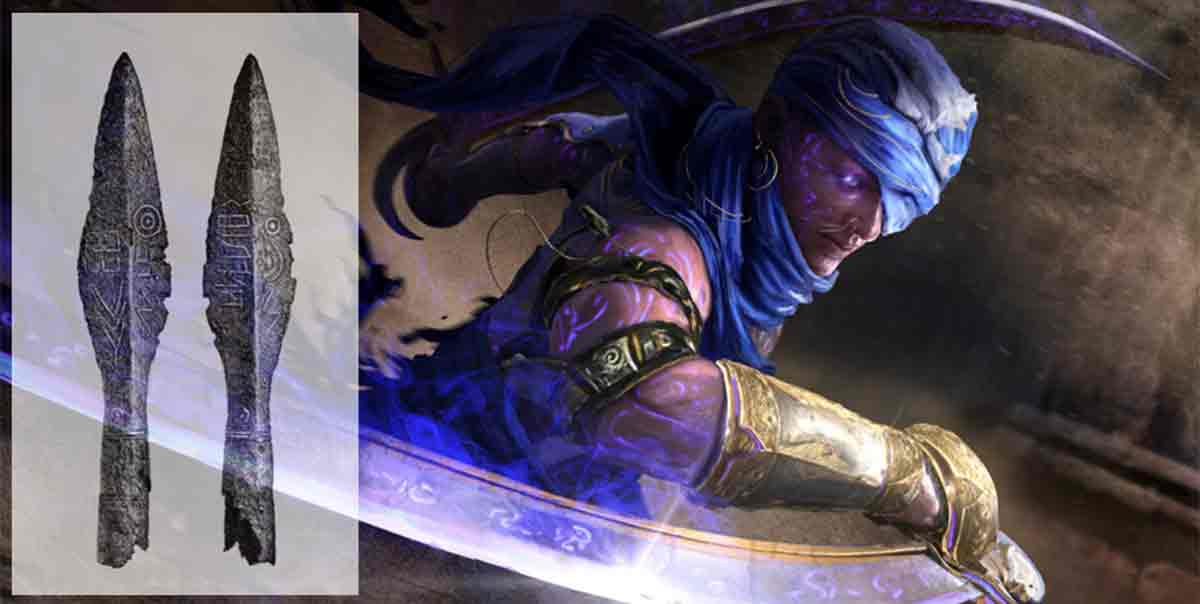How Arabian Script Infiltrated the Runes of Ancient Germany
Arabian archers in the Roman army had a surprising impact on the evolution of writing in ancient Germany at the dawn of our Common Era (AD). The old Germanic alphabet, known as runes – bolstered with letters from the language of the Arabian Nabateans – has survived to the present day, appearing in fantasy tales like The Lord of the Rings and Harry Potter, and in an array of modern video games.
Most people know the story of the incursion of Arab military forces into Europe that began in 711 AD. The Arabian Muslim troops, who had crossed North Africa and entered into Spain from Morocco, were eventually halted by indigenous Spaniards, and gradually driven back southward over the course of centuries. By 1492, the Arabian forces were ousted from Europe.
But this wasn’t the first Arab incursion into Europe. Archaeologists have discovered evidence of the movement of Arabian soldiers into Germany at least half a millennium before their entry into Spain. These troops were archers – auxiliary soldiers specialized in warfare with bows and arrows. The evidence was found in runes inscribed on ancient German objects recovered as far north as Denmark in Scandinavia and dating back to the 2nd century AD.
- The Northern Mysteries Current: Futhark and Mystery Schools of the Viking Age
- Runic expert cracks 900-year-old secret Viking code
Influence of Nabatean Alphabet on Runic Script
About a thousand Nabatean archers, armed with Scythian bows and arrows tipped with triangular arrowheads, served in the army of the Roman Empire, most of them probably at Sorviodurum, a Roman auxiliary fortress located in the Bavarian town of Straubing on the Danube River, about 142 kilometers (88 mi) northeast of Munich.
These soldiers from Arabia brought with them knowledge of their alphabet all the way up north to the outer border of the Roman Empire, along the Rhine and Danube rivers, and beyond, to Denmark and other parts of Scandinavia.
Most runes were based on Latin letters, but five or more of them appear to have been derived from Aramaic Semitic letters. This unexpected discovery was first discussed by Swedish linguist John Troeng in an academic paper in 2003.
- Oldest Arabic Inscription Provides Missing Link Between Nabatean and Arabic Writing
- Discover the Hidden Roots of the Runes
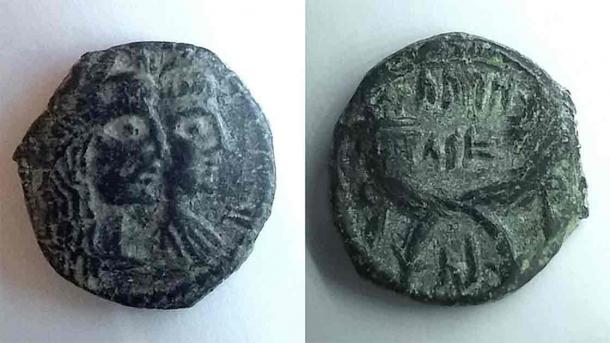
Coin from the Nabataean Kingdom, Left: Aretas IV and Shaqilath, 9 BC. – 40 AD. (Right) On the reverse, an example of Nabataean script: names of Aretas IV (1st line) and Shaqilath (2nd and 3rd line). (Starnutoditopo/CC BY-SA 4.0)
“Though most Germanic runes probably derive from Latin letters, some of them cannot be convincingly derived from that source,” Troeng reported. He found that at least five runes – and probably more – were better explained as originating from letters in the Aramaic Semitic alphabet of the Nabateans.
Troeng identified as many as nine runic letters whose shape and sound were probably inspired by the alphabet used in the Nabatean kingdom, which extended from present-day Sinai into southern Israel and Jordan.
The runes for the letters th (O), g, w, j, and z – and probably also p, e, m, and l – appear to have been derived from Nabatean letters, Troeng said. Most of these Semitic-origin runes conveyed sounds that traditional Roman runes didn’t cover.
“The runic alphabet is the only European alphabet known to have had meaningful letter names such as the Semitic alphabets have,” the Swedish linguist noted. “The name of the first rune, fehu ‘cattle,’ and the name of the first Semitic letter, alef ‘ox,’ have practically the same meaning…. This supports the idea that a Semitic alphabet was at least one of the models of the runic alphabet.”
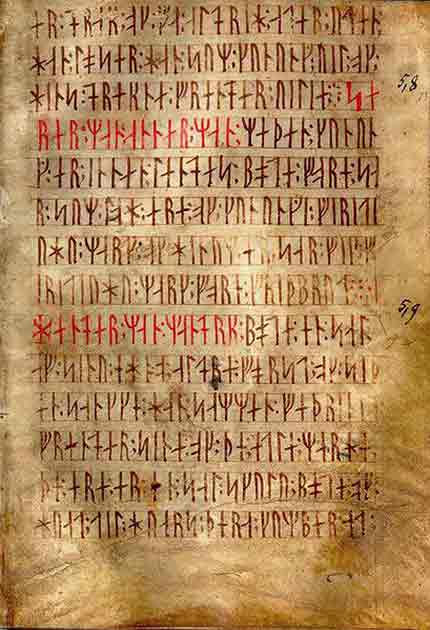
Codex Runicus, a vellum manuscript from approximately 1300 AD containing one of the oldest and best-preserved texts of the Scanian Law, is written entirely in runes. (Public Domain)
Military Infrastructure in Straubing
The Nabateans were a prosperous Arab people who in ancient times – the 3rd century BC to the 1st century AD – controlled long-distance commerce between Mesopotamia and Egypt and between South Arabia and the Mediterranean coast, and who also participated in the lucrative Mediterranean trade. The Nabateans in their early days were based at Petra, whose dramatic ruins are found in present-day Jordan.
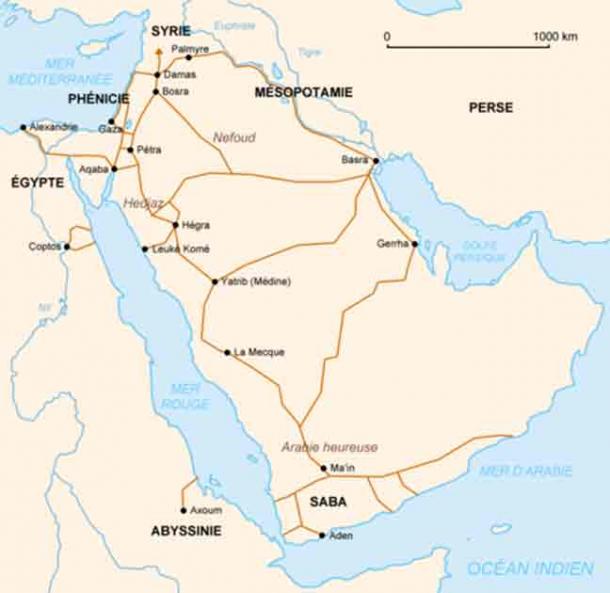
Nabataean trade routes. (Like tears in rain/CC BY-SA 3.0)
Nabatean inscriptions have been identified through Europe, in locations like the Greek archipelago, Puteoli near Naples, and Rome itself. After 106 AD, when the Romans took control of the Nabatean kingdom and transformed it into a province known as Arabia Petraea (or Roman Arabia), Nabatean soldiers began to be recruited into the Roman military.
Two cohorts recruited in Arabia Petraea were stationed on the limes, or Roman frontier, in Germany. The Limes Germanicus was some 353 miles (568 km) long and included about 60 forts and 900 watchtowers.
The Canatha cohort, consisting mostly of Nabatean archers, was recruited from the Hauran in Roman-controlled Arabia, and was stationed in the Bavarian city of Straubing (then called Sorviodurum) sometime during the years 121 to 128 AD.
Canatha – today, the modern Syrian village of Qanawat – was only 40 km (25 mi) north of Bosra, or Bostra, a Syrian city that served as the northern capital of Roman Arabia, replacing Petra in the 1st century AD.
While Canatha wasn’t actually located in Roman Arabia at that time, but instead a few kilometers north of the Syrian border, the Canatha cohort consisted of soldiers mainly of Nabatean origin. When the cohort was based in Bavaria, it received a continuing flow of recruits from Arabia Petraea. Military diplomas indicate that the Canatha cohort was still based at Straubing in 166, but diplomas are lacking after that time.
The Romans set up small troop camps on the Danube frontier in eastern Bavaria – the eastern part of the Roman province of Raetia – around the middle of the 1st century. These camps monitored traffic on the river and served as stations for ship crews. Judging from recent archaeological finds, one of these camps was situated on the hilltop in eastern Straubing where the church of St. Peter now stands.
At about the same time in the 1st century, the Romans developed Straubing’s natural bay into a fortified harbor, consisting of a riverside quay and several wooden piers. Ship repairs were carried out on a nearby natural beach.
The Romans also built a fort in western Straubing at this time, and a 500-strong cavalry force was stationed there. About a decade later, the Romans built Straubing’s eastern fort on St. Peter’s hill, which was designed to be manned by a 1,000-member garrison. Before the mid-2nd century, a partially mounted unit of 1,000 soldiers moved into the eastern fort, making Straubing the most important Roman military site on the Eastern Roman Limes.
Meanwhile, an extensive civilian settlement grew in Straubing/Sorviodurum, in part supporting the troop camps but also providing many specialized craftsmen for both the city and the camps. Historians estimate that about 5,000 people lived in Sorviodurum at that time.
Rediscovery and Decipherment of Elder Futhark Runic Script
A runic writing system was developing in northern Europe during this period, based on the Elder Futhark (or Fuþark) runes. This was the oldest known form of the runic alphabets and was a system used by Germanic peoples for Northwest Germanic dialects in the Migration Period (sometimes called the “Barbarian Invasions,” from about 300 to 700 AD).
Evidence is currently lacking on whether the runic script was invented at Straubing, or in Denmark, or somewhere else.
“No runological problem is as controversial as the origin of the futhark,” says Troeng. “Attempts have been made to derive it from the Latin, Greek and North Italian alphabets. None of these can explain the forms and sound values of all the runes satisfactorily.”
Surviving inscriptions in Elder Futhark have been found on artifacts including jewelry, amulets, plate ware, tools, and weapons, as well as on runestones in Scandinavia, from the 2nd to the 10th centuries AD.
In Scandinavia, beginning in the late 8th century, the script was simplified to the Younger Futhark, while Anglo-Saxons and Frisians made further changes, giving rise to the Anglo-Saxon variant futhorc, whose name is based on the Old English sound values of the first six runes: f, u, th, a, r, and k.
Both the Anglo-Saxon futhorc and the Younger Futhark remained in use during the Early and the High Middle Ages, respectively (from 500 to 1050 and from 1050 to 1300 AD). Unfortunately, knowledge of how to read Elder Futhark was forgotten until 1865, when it was deciphered by Norwegian philologist and rune scholar Elseus Sophus Bugge.
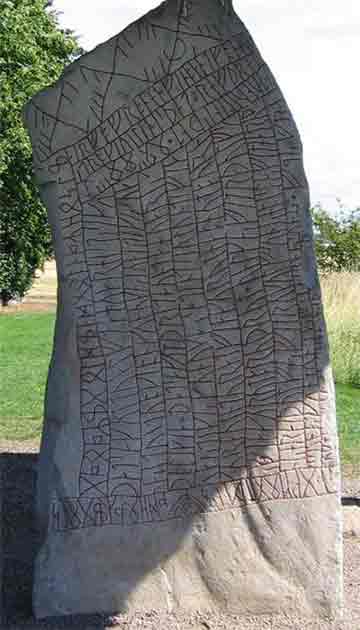
The Rök Runestone (Ög 136), located in Rök, Sweden features a Younger Futhark runic inscription that makes various references to Norse mythology. (Wiglaf/CC BY-SA 3.0)
“The oldest known runic inscription from Sweden is found on a spearhead, recovered from a grave at Mos in the parish of Stenkyrka in Gotland,” says Sven Jansson, a leading Swedish runologist. “The inscription, consisting of only five runes, might be dated to the end of the third century of our era.” Gotland is Sweden’s largest island and is located off the east coast of the mainland.
Emergence of the Bavarians
Under the Roman Emperor Antoninus Pius – in the middle of the 2nd century AD – trouble was looming north of the Danube, in what would prove to be the leadup to the Marcomannic Wars. These were a series of conflicts lasting from about 166 until 180 AD, pitting the Roman Empire against tribes such as the Germanic Marcomanni and Quadi and the Sarmatian Iazyges, as well as other peoples living north of the Danube.
Many Roman military installations were constructed of stone, including those of Sorviodurum. Roman Sorviodurum was badly affected in the later 2nd century. Large areas of the civilian settlement and the western Roman fort were destroyed. Later, new houses were built in the civilian settlement, but the western fort was abandoned. In the Danube River harbor, only the quays – river-bank segments modified for ships to dock parallel to the shore – remained in active use, and the old wooden piers fell into disrepair.
However, Roman life did not end at the larger fort locations after these destructions; new fortifications developed, including the late-antique fort located on the church hill of St. Peter.
An invasion by the Germanic Juthungen tribe in 357 AD had a devastating effect on eastern Bavaria. Many military sites, including Straubing, were damaged during this invasion, and rural life came to a nearly total standstill. Roman military camps continued to survive well into the 5th century, but there was an increasing influx of Germanic tribes into Bavaria from across the Danube.
During this period, the last late-antique population was absorbed into the gradually emerging tribe of the Bavarians (called Baiuvarii by the Romans), who are the ancestors of modern-day Bavarians and Austrians.
Impact of Arab Auxiliaries on Runic Evolution
Roman army auxiliaries from Africa and Asia who were stationed on the limes in Europe in the 2nd century AD were believed to be the only people who could have provided a non-European model for the runic script.
Professional archers on the Rhine and Upper Danube limes were members of three cohorts from Syria and Roman Arabia, according to Troeng. Two of the cohorts were on the Rhine limes (at Friedberg in Hessen, and at Mainz) and the third one was the Canatha cohort at Straubing.
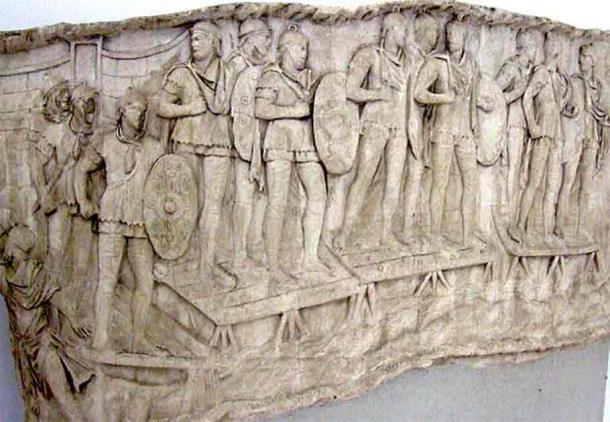
Roman auxiliary infantry crossing a river, probably the Danube, on a pontoon bridge. Romanian National History Museum (CristianChirita/CC BY-SA 3.0)
The Roman army units that included significant numbers of Nabatean archers (equipped with Scythian bows and triangular arrowheads), and that were stationed along the Rhine or the Upper Danube in Early Imperial times (1st to 4th centuries), were:
- The Damascus cohort (Cohors I Flavia Damascenorum from Syria), based at Friedberg in Hessen,
- The Iturea cohort (Cohors I Ituraerorum from Arabia Petraea), based at Mainz, and
- The Canatha cohort (from Hauran, Arabia Petraea), based at Straubing.
The professional archers who used the long bows found in modern times in the peat bog at Thorsbjerg (formerly Danish territory and now part of northern Germany), and the triangular points discovered at different sites throughout Denmark, had probably served in one of these three units.
The Iturea cohort departed from Germany in 88 AD, the Damascus cohort remained at Friedberg until at least 134 AD, and the Canatha cohort stayed at Straubing until at least 166 AD, according to military diplomas.
The Arab archers among the Roman army auxiliaries on the Straubing limes were natives of Syria and Arabia Petraea, as well as of the Roman provinces of Mauretania (the ancient Maghreb) and Africa Proconsularis (Algeria, Tunisia, and Libya). Most, as we have seen, were from Arabia Petraea.
All, or almost all, of the Arab auxiliaries are believed to have used Semitic scripts, according to Swedish linguist Troeng. And so, as a result, these archers likely had an important impact on the evolution of the runes of northern Europe.
19th Century Movements and Runic Resurgence
Runic alphabets that include Nabatean additions have seen numerous uses over the years, including during the 18th century Viking revival, as well as during at least two 19th century movements: Scandinavian Romantic nationalism (known as Gothicism) and the modern German occult revival of 1880-1910.
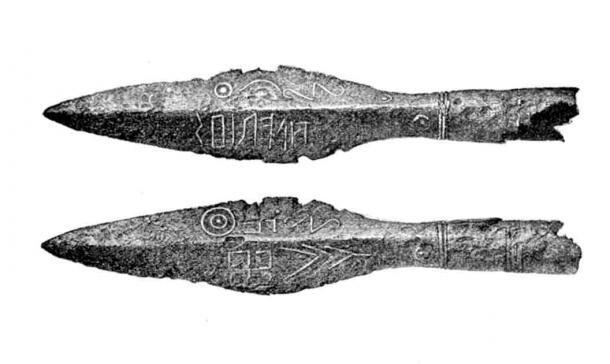
The Spearhead from Kovel. Runes. Identified as East Germanic (Gothic) because of the nominative -s (in contrast to Proto-Norse -z). (Public Domain)
Runes have also made appearances in 20th century fantasy literature and films, notably J.R.R. Tolkien’s The Hobbit and The Lord of the Rings and J.K. Rowling’s Harry Potter series, as well as in modern Germanic Heathenry, a religious movement of the 1970s.
Finally, it’s worth noting that runic letters feature extensively in numerous modern video games that incorporate themes from early Germanic cultures.
Top image: AI image of Arab warrior assassin rushing through the desert with two curved sabers with which magical Arabian runes. Source: warmtail/Adobe Stock
Robert W. Lebling is a writer/editor, communication specialist/consultant and book author. He has extensive experience in Middle East affairs, Arab and Islamic society and culture, energy (oil & gas), the chemical/petrochemical industry, technology, environment, U.S. politics and government, and foreign affairs.
Lebling’s books include Legends of the Fire Spirits: Jinn and Genies from Arabia to Zanzibar and Natural Remedies of Arabia
Website: https://www.scribd.com/user/12107296/Robert-W-Lebling-Jr















